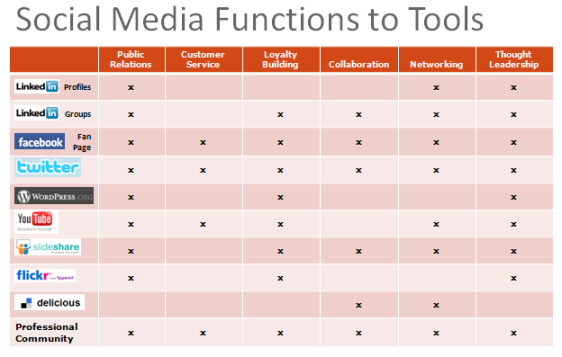In my Social Media 101 presentation to a group of marketers from E&Y last week, I included the beginnings of a social media framework that has been on my mind recently. This post explains how I will be using the framework to address social media strategy needs for my clients.
One more thing – the tables below are slanted toward a B2B social media strategy, but could easily be modified for a B2C or hybrid strategy.
The first table looks at the six primary social media functions. I first saw this list of functions in a presentation by Marta Kagan and have been using them to explain the different areas that social media can address. Against the six social media functions, I mapped the key social media tools that can be used to address these functions. I could have used generic categories such as blog, video, social networking and bookmarking and I omitted some categories for my audience such as wikis, user review sites and forums.
Once I plotted the intersections, it is interesting to see that not every tool addresses each function. Some people may argue that if you make the bus big enough, you could probably justify any of the tools for any of the functions – but I have limited the intersections to their most typical usage.
After mapping the social media functions to tools, the next important step was to assign priority to each tool. Along with the priority, it is also key to understand both the upfront effort and the ongoing effort for each tool. For example, creating and maximizing your LinkedIn profile is a high priority that has moderate upfront effort and a low ongoing effort score.
There are better ways to to quantify effort, but they are difficult to document without further knowledge of the situation. After spending some time doing discovery with a specific client, I would most likely assign hours or days of effort. For now, the table below just identifies relative effort levels.
As you can see above, I would rank LinkedIn Profiles and Groups, a blog and Slideshare as high priority implementations. But each one comes with different levels of both upfront and ongoing effort. And I would put blogging and managing a community in the high category for ongoing effort which explains why many companies choose not to implement these tools despite their relative priority.
The framework is also a work in progress so any comments are welcome.

